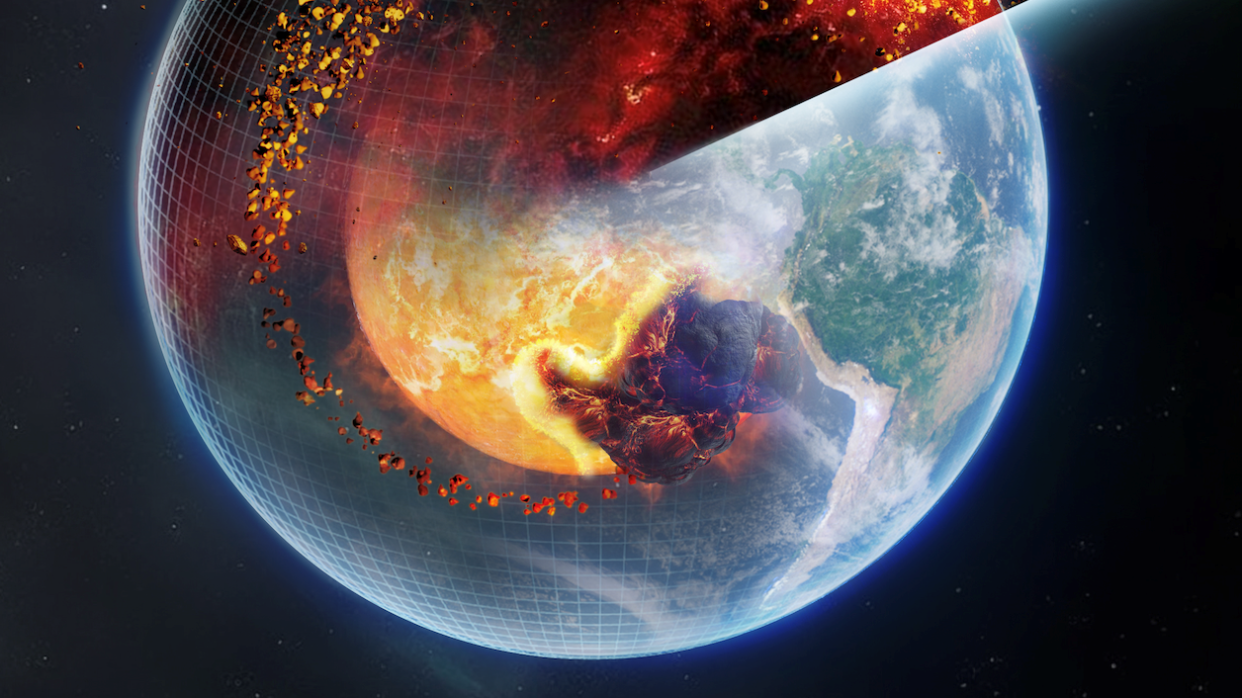2% of Earth's Mass May Be Debris From the Massive Collision That Formed the Moon

"Hearst Magazines and Yahoo may earn commission or revenue on some items through these links."
Deep below the Earth’s crust, along the mantle-core boundary, are dense geological blob-like anomalies known as large low-shear-velocity provinces.
Although many hypotheses explain these anomalies, the Giant Impact Hypothesis is a front-runner. This concept states that these blobs are actually remnants of Earth’s Moon-forming crash with the proto-planet Theia from 4.46 billion years ago.
Now, a new study provides detailed simulations that show how Theian material could now make up two percent of Earth’s mass along this mantle-core boundary.
The creation of the Earth-Moon system is a drama tailor-made for Hollywood. Two newly formed planetary siblings, sharing the same solar orbit in harmony, suddenly crash together due to gravitational disturbances in the early Solar System. But from that chaotic collision arises an unending connection that lasts 4.46 billion years and the only life-sustaining planet (that we know of)—Earth.
Oh, and the explosions? Don’t even get us started.
For the past 50 years, this cataclysmic smash-up has evolved from one hypothesis among many to the leading candidate for explaining how the Earth-Moon system formed. Now, new research from an international team of scientists says that evidence of this primordial collision can still be found in the Earth’s lower mantle. Hongping Deng—an astrophysicist from the Chinese Academy of Sciences—used a new fluid dynamics technique called Meshless Finite Mass (MFM) to simulate this ancient collision. The results were published on Wednesday in the journal Nature.
“Previous research had placed excessive emphasis on the structure of the debris disk (the precursor to the Moon) and had overlooked the impact of the giant collision on the early Earth," Deng said in a press statement. “"Our findings challenge the traditional notion that the giant impact led to the homogenization of the early Earth. Instead, the Moon-forming giant impact appears to be the origin of the early mantle’s heterogeneity and marks the starting point for the Earth’s geological evolution over the course of 4.5 billion years.”
The two biggest examples of this heterogeneity (proto-Earth had a higher silicon content than Theia did) is found in two large low-shear-velocity provinces (LLVP) located deep beneath Africa and the Pacific Ocean. These vast, dense regions along the mantle-core boundary were found using seismic measurements and scientists have even mapped them in detail. Some theories suggest that these regions are old tectonic slabs, or an anomalous magma ocean at the base of the mantle. But the possibility that these blobs are remnants of the proto-planet Theia is also starting to emerge.
In 2021, University of Arizona Ph.D. student Qian Yuan—now a geophysics post-doc at Caltech—theorized that the iron-rich (and thus intrinsically denser) Theian material traveled to the lower mantle and formed these LLVPs after long-term mantle convection.
Deng’s new simulations confirm that the early Earth experienced mantle stratification after impact, meaning that the mantle swirled with material from both Theia and Earth, while the core remained unchanged. The simulations also reveal that Theian material equal to two percent of the Earth’s mass eventually entered this low mantle region.
“Through precise analysis of a wider range of rock samples, combined with more refined giant impact models and Earth evolution models, we can infer the material composition and orbital dynamics of the primordial Earth...and Theia,” Yuan said in a press statement. “This allows us to constrain the entire history of the formation of the inner solar system."
Earth is a unique gem in the Solar System, and as far as we can tell, in the known universe. Understanding the early days (or early millions of years) during which our planet formed could provide valuable insight into what makes our Earth so special in the first place.
You Might Also Like

